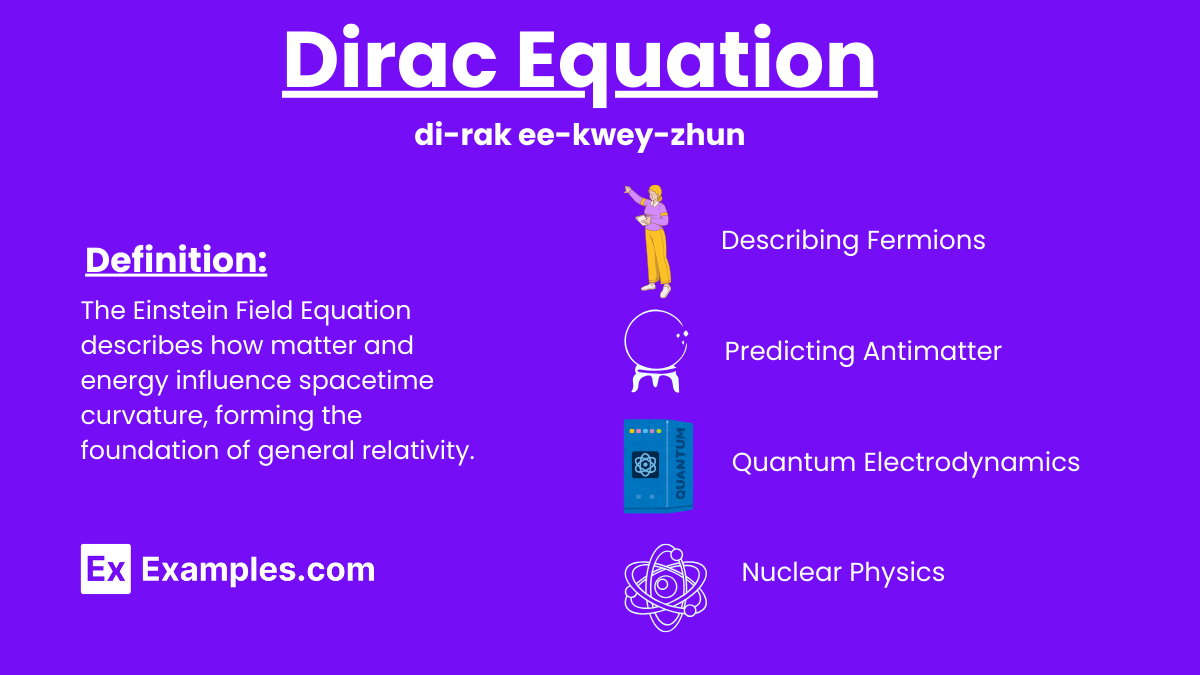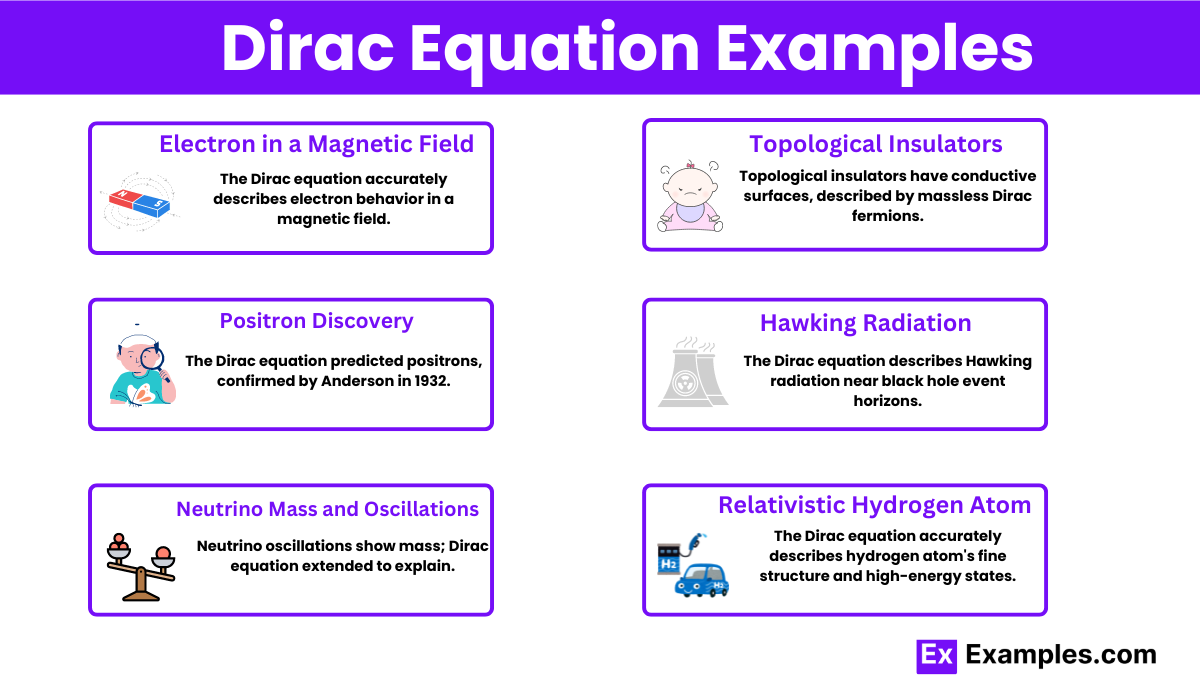What does the Dirac equation describe?
Motion of classical particles
Quantum states of fermions
Electromagnetic waves
Gravitational forces


The Dirac Equation, formulated by British physicist Paul Dirac in 1928, is a fundamental equation in quantum mechanics that describes the behavior of fermions, such as electrons. This relativistic wave equation merges quantum mechanics and special relativity, predicting the existence of antimatter and explaining the intrinsic spin of particles. The Dirac Equation is essential for understanding the quantum behavior of particles at high velocities, where traditional Schrödinger equation fails. Its applications are vast, ranging from particle physics to quantum field theory, making it a cornerstone of modern theoretical physics.
The Dirac Equation is a fundamental equation in quantum mechanics and quantum field theory, formulated by physicist Paul Dirac in 1928. This relativistic wave equation describes the behavior of fermions, such as electrons, which are particles that follow Fermi-Dirac statistics. The equation successfully merges the principles of quantum mechanics with special relativity, providing a more complete understanding of particle dynamics at high velocities.
The Dirac Equation is a relativistic wave equation fundamental to quantum mechanics and special relativity. It describes the behavior of fermions, such as electrons, in a manner consistent with both principles.
( iγμ∂μ − m)ψ = 0
These physical constants reflect the integration of special relativity and quantum mechanics. The Dirac Equation was formulated to study the relative motion of electrons and to treat the atom in a manner consistent with relativity, providing deeper insights into the behavior of particles at high velocities and the nature of antimatter.
In quantum mechanics, the Dirac field helps resolve various paradoxical features. The Dirac sea concept, explored through hole theory, suggests that the vacuum is filled with a sea of negatively charged electrons occupying negative energy states. These electrons reside in their respective eigenstates.
The Dirac field is a quantum field that describes fermions, particles with half-integer spin, such as electrons. Introduced by British physicist Paul Dirac in 1928, the Dirac field is governed by the Dirac equation, a relativistic wave equation. This field reconciles quantum mechanics with special relativity and accounts for the existence of antimatter. In the context of the Dirac sea, it suggests that the vacuum is a sea of negative energy states filled with electrons, where the absence of an electron (a “hole”) behaves as a positively charged particle, or positron. The Dirac field’s mathematical formulation uses four-component spinors, which encode the properties of particles and antiparticles. This framework has been fundamental in the development of quantum field theory and the Standard Model of particle physics, providing a deeper understanding of the behavior and interactions of fundamental particles.
The Dirac equation, a cornerstone of quantum mechanics and quantum field theory, has several alternative formulations that provide different insights or simplify calculations in various contexts. Here are some of the notable formulations:
The Foldy-Wouthuysen transformation aims to separate positive and negative energy states more clearly, providing a more intuitive interpretation of the Dirac equation in the non-relativistic limit. It transforms the Dirac Hamiltonian into a form where the upper and lower components of the spinor represent particle and antiparticle states distinctly.
In the Weyl or chiral representation, the Dirac spinor is expressed in terms of two-component spinors, often called Weyl spinors. This formulation emphasizes the chirality (handedness) of particles and is particularly useful in the study of neutrinos and electroweak interactions in the Standard Model, where chirality plays a crucial role.
The Majorana representation is used to describe Majorana fermions, particles that are their own antiparticles. In this formulation, the Dirac spinor is real rather than complex, which simplifies the equations for such particles. This approach is significant in theoretical and experimental investigations of neutrinos.
In this formulation, the Dirac equation is written explicitly to incorporate the principles of relativity. It uses the gamma matrices and the spinor field to describe the behavior of relativistic particles. This is the most commonly used form and serves as the basis for most quantum field theory applications.
In QFT, the Dirac equation is embedded within the framework of field operators. The Dirac field becomes an operator that creates and annihilates particles and antiparticles. This approach is essential for describing particle interactions, decay processes, and the creation and annihilation of particle-antiparticle pairs.
The covariant formulation emphasizes the Lorentz invariance of the Dirac equation. Here, the equation is written in a form that explicitly shows its invariance under Lorentz transformations. This is crucial for ensuring that the physical laws described by the Dirac equation hold true in all inertial reference frames.
These alternative formulations highlight the versatility and depth of the Dirac equation in describing a wide range of physical phenomena, from the behavior of elementary particles to the foundational principles of quantum field theory and relativity.
The Dirac equation has numerous applications in various fields of physics, demonstrating its profound impact on our understanding of the quantum world. Here are some key uses:
Describing Fermions : The Dirac equation accurately describes particles with half-integer spin, known as fermions, such as electrons, muons, and quarks. It predicts their behavior, including their spin and magnetic moment, with great precision.
Predicting Antimatter : One of the most significant predictions of the Dirac equation is the existence of antimatter. The equation’s solutions include both positive and negative energy states, leading to the theoretical prediction of positrons (the antimatter counterpart of electrons). This was experimentally confirmed by Carl Anderson in 1932.
Quantum Electrodynamics (QED) : The Dirac equation is foundational in quantum electrodynamics, the theory that describes how light and matter interact. It provides the framework for calculating processes such as scattering and annihilation involving electrons and photons.
Relativistic Quantum Mechanics : Incorporating special relativity into quantum mechanics, the Dirac equation explains the behavior of particles at high velocities, close to the speed of light. This is crucial for understanding phenomena in high-energy physics and cosmology.
Condensed Matter Physics : In condensed matter physics, the Dirac equation models the behavior of quasi-particles in materials like graphene and topological insulators. These materials exhibit properties that can be described using relativistic equations, leading to potential applications in electronics and quantum computing.
Nuclear Physics : The Dirac equation helps describe the behavior of nucleons (protons and neutrons) within atomic nuclei. It aids in understanding nuclear structure and interactions, particularly in the context of the strong nuclear force.

Electron in a Magnetic Field : When an electron moves in a magnetic field, the Dirac equation provides a complete description of its behavior, including the spin interaction with the magnetic field. The relativistic corrections predicted by the Dirac equation match experimental observations of the electron’s magnetic moment.
Positron Discovery : The Dirac equation predicted the existence of positrons, the antimatter counterparts of electrons, as solutions to negative energy states. This prediction was confirmed in 1932 when Carl Anderson observed positrons in cosmic rays, providing direct evidence for antimatter.
Graphene and Condensed Matter Physics : In materials like graphene, electrons behave as if they are relativistic particles, even though their actual speeds are much lower than the speed of light. The Dirac equation models these electrons as massless Dirac fermions, explaining the unique electronic properties of graphene, such as its high conductivity and the presence of Dirac cones in its electronic band structure.
Neutrino Mass and Oscillations : Neutrinos were initially thought to be massless, but the discovery of neutrino oscillations implies they have a small mass. The Dirac equation can be extended to include mass terms for neutrinos, allowing for the theoretical framework needed to understand these oscillations and their implications for particle physics.
Topological Insulators : Topological insulators are materials with insulating interiors but conductive surfaces. The surface states of these materials are described by the Dirac equation, with massless Dirac fermions accounting for the robust, dissipationless edge currents that are protected by the material’s topology.
Hawking Radiation : Near the event horizon of a black hole, the Dirac equation helps describe the creation of particle-antiparticle pairs, leading to Hawking radiation. This phenomenon results from quantum effects in strong gravitational fields and is pivotal in understanding black hole thermodynamics.
Relativistic Hydrogen Atom : The Dirac equation provides a more accurate description of the hydrogen atom than the Schrödinger equation, especially for high-energy states. It predicts the fine structure of the hydrogen spectral lines, accounting for the relativistic effects and spin-orbit coupling that were previously unexplained.
Proton Decay in Grand Unified Theories : In certain grand unified theories (GUTs), the Dirac equation is used to describe the behavior of particles and predict phenomena like proton decay. These theories aim to unify the fundamental forces and require the Dirac equation to describe fermions consistently within the framework.
Muon g-2 Anomaly : The Dirac equation contributes to the theoretical calculations of the magnetic moment of the muon. Discrepancies between experimental measurements and theoretical predictions, known as the muon g-2 anomaly, suggest possible new physics beyond the Standard Model. The Dirac equation forms the basis for these theoretical predictions.
It combines quantum mechanics and special relativity, predicting the existence of antimatter and explaining the fine structure of atomic spectra.
Fermions are particles that follow Fermi-Dirac statistics, including electrons, protons, and neutrons, and have half-integer spin values.
It predicted the existence of antimatter, specifically the positron, which was experimentally confirmed in 1932.
The Dirac Equation naturally incorporates spin-½ particles, providing a theoretical basis for understanding their intrinsic angular momentum.
A spinor is a mathematical object used in the Dirac Equation to describe the quantum state of fermions, including their spin properties.
Gamma matrices are used in the Dirac Equation to satisfy the requirements of Lorentz invariance and to describe the spin and relativistic properties of particles.
The Dirac sea is a theoretical model in which all negative energy states are filled, explaining the existence of positrons as holes in this sea.
It provided a foundation for quantum field theory, influencing the development of concepts like particle creation and annihilation.
The solutions include wave functions for particles and antiparticles, reflecting their probabilistic behavior in quantum mechanics.
The Dirac Equation is relativistic and incorporates spin, while the Schrödinger Equation is non-relativistic and does not account for spin.
Text prompt
Add Tone
10 Examples of Public speaking
20 Examples of Gas lighting
What does the Dirac equation describe?
Motion of classical particles
Quantum states of fermions
Electromagnetic waves
Gravitational forces
Who formulated the Dirac equation?
Albert Einstein
Niels Bohr
Paul Dirac
Erwin Schrödinger
What fundamental particle's behavior is primarily explained by the Dirac equation?
Photon
Electron
Proton
Neutron
Which of the following concepts is incorporated in the Dirac equation?
General relativity
Special relativity
Classical mechanics
Thermodynamics
What is a key feature predicted by the Dirac equation?
Electron spin
Wave-particle duality
Photoelectric effect
Quantum entangle
What type of particles does the Dirac equation apply to?
Bosons
Fermions
Mesons
Photons
Which concept does the Dirac equation introduce to explain negative energy solutions?
Photon energy levels
Virtual particles
Dirac sea
Heisenberg uncertainty
What are gamma matrices in the context of the Dirac equation?
Matrices representing spin operators
Matrices describing energy levels
Matrices used to linearize the Klein-Gordon equation
Matrices representing position operators
How many components does the Dirac spinor ψ have?
2
3
4
5
What does the Dirac equation predict about the electron's magnetic moment?
It is zero
It is proportional to its charge
It has an anomalous magnetic moment
It is independent of its spin
Before you leave, take our quick quiz to enhance your learning!

